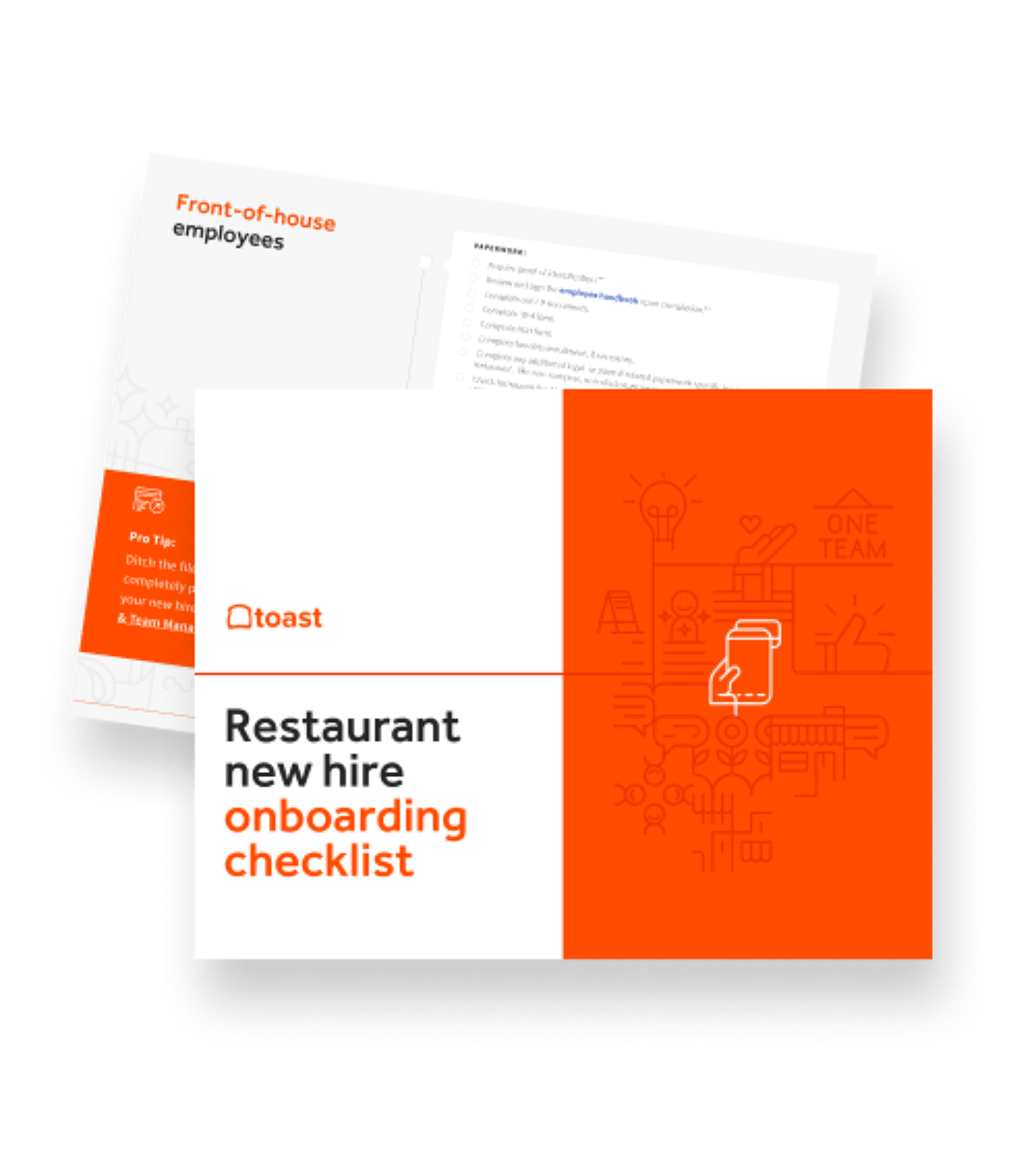
How to Make Your Staff Measurably Happy
Workplace happiness is one of the hardest metrics to move in a restaurant. These two restaurateurs share their tips on building happier teams.

Dana HaticAuthor


Restaurant New Hire Onboarding Checklist
Bringing new employees onto your team can be both exciting and challenging. Use this free PDF checklist to set your staff up for success.
Get free downloadFor the champions who keep our industry running, restaurant work requires long hours, atypical schedules, and few days off. The grind is real, and it impacts the health, financial stability, and satisfaction of all types of restaurant employees, no matter their role or tenure.
Feedback from restaurant workers indicates low overall employee happiness compared with other industries, leaving restaurateurs with the task of confronting employee turnover by analyzing standards of workplace happiness and coming up with solutions to make the hospitality industry actually hospitable for its workers.
What Is Workplace Happiness?
There are several factors that influence workplace happiness, including those needed for daily motivation (like wages, bonuses, and benefits) and others that result in long-term satisfaction (like financial stability, stress, health, and growth opportunities). But workplace happiness in the restaurant industry is unique.
If your goal is happiness, it’s not very actionable, Happiness is one of the outputs of something much deeper and much more important.

Josh Lewin
Co-owner of Bread + Salt Hospitality
Restaurants face high employee turnover, with data from a Bureau of Labor Statistics program reflecting a 74.9% turnover rate at restaurants in 2018, elevated from 72.5% in 2017. This number far outpaces the average rate in private sector jobs, which is estimated at 48.9% for 2018.
Staff who are employed in restaurants, pubs, bars, cafes, or in catering might turn over quickly in part due to demographics — restaurants employ high numbers of teenagers, students, and seasonal staffers — and the cost of turnover per employee for restaurants can reach thousands of dollars, when it comes to training, onboarding, and ultimately productivity loss.
This cycle becomes a self-fulfilling prophecy, where employers avoid investing in employees believing they will leave within two to three months.
The goal is to find what employees need to be happy, Josh said. “If you’re working toward that in a healthy way and with support, happiness is what happens, and happiness is really nice, but it doesn’t support itself without having a reason for being.”
Taking the student workers out of the equation, though, the restaurant employee turnover situation remains bleak at best, with hospitality workers reporting lower happiness than those in other industries.
Here, we look into ways of measuring workplace happiness, along with tested and evolving methods for improving happiness in restaurants.
How to Measure Happiness in the Workplace
The vague and arbitrary parameters of what constitutes happiness can vary across industries and even across restaurants. But employers do have certain metrics available for measuring staff satisfaction. Among these is the employee net promoter score, taken from a survey designed to measure satisfaction by averaging detractors (indicating negative feedback), passives (indicating no measurable detriment or contribution), and promoters (indicating satisfaction or good word-of-mouth).
Why is a net promoter score important?
The net promoter score can be used to measure whether employees feel positively toward a workplace and whether they would recommend it as a place of employment to a friend or colleague, or to potential patrons. On a scale of 0 to 10, detractors fall in the zero to six range, passives fall in the six to nine range, and promoters fall in the nine to 10 range.
How to calculate net promoter score.
To calculate an employee net promoter score, restaurateurs can survey their employees, subtracting the number of detractors from the number of promoters and dividing that number by the total number of respondents multiplied by 100.
Employee Feedback Template
Use this customizable Word doc to guide self, peer, and manager reviews with your employees.

What is a good net promoter score?
Generally dependent on the number of respondents, a good net promoter score will ideally fall in the promoter range, but companies can generally use this metric to get a quick look at overall happiness. That said, the ENPS is not a catch-all representation of workplace happiness. Before implementing a survey like this, restaurant managers and owners should have methods of following up on the responses.
Those administering surveys should be prepared to ask “why” of detractors and promoters alike to see what specific reasons employees have for recommending the company or not. This can provide insights into what employers are doing well and where there remains room for improvement.
Managers and owners should also share results of surveys with employees to increase engagement and investment in the feedback process and to make space for collaboration on improvement plans.
3 Ways to Improve Workplace Happiness in Your Restaurant
Metrics can be a helpful tool for checking on the overall morale within restaurants, but once businesses receive feedback, managers and owners have to take action in response. In smaller businesses, employers might use different methods to engage their employees, listen to concerns, and implement change to see growth in the happiness within their restaurants.
1. Rethink the work week.
Earlier this year, Shake Shack stepped in a new direction toward increasing workplace happiness by testing a four-day workweek for their managers in Las Vegas. Following some success, in November the company expanded that program, reporting employee feedback of improvements to their lifestyles, including the ability to save on childcare.
And while resources for large restaurant businesses like Shake Shack are vast, small businesses also have tools available for improving overall morale by incentivizing the time employees invest in their workplace. This may include offering advancement training for different positions within the restaurant and providing opportunities through regular meetings or surveys for staff to pitch ideas, address issues, and share goals.
2: Listen to employees and collect regular feedback
“One of the stories that I always tell is about our first-ever hire,” said Irene Li, co-owner of Mei Mei, a Chinese-American restaurant in Boston that she launched with her two siblings as a food truck in 2012 before opening a permanent location. “Her name is Emily, and she had actually dropped out of her program in neuroscience at MIT and sent us her deeply overqualified application,” Irene said, noting that much of Mei Mei’s staff fit a similar profile: highly educated individuals who had potential to make more money at other jobs. “In thinking about that, I really wanted to try to honor their choice to do this work that is sometimes menial and almost never glamorous as a way of appreciating their service to me, to our guests, to our industry, and trying to make it a job that they are proud to do.”
The work is hard and it’s not very profitable. People have limited internal resources to care for each other.”

Irene Li
Co-Owner, Mei-Mei Restaurant Group
Mei Mei’s retention rates are quite high compared with industry standards: Irene estimates her employees stay an average of two and a quarter years, while across the industry, 42% of front-of-house workers leave within three months and 43% of managers leave within a year. Mei Mei provides competitive wages, growth opportunities, guidance for navigating healthcare services, and educational programs for its staff. For folks who leave the restaurant, it’s not for a more competitive position, according to Irene. “For the most part, people are leaving to transition to other industries,” she said, acknowledging that the burnout rate across restaurants tends to be high.
“Probably the root cause is that the business model for restaurants is inherently very difficult,” Irene said. “It creates immense pressure that starts at the top of the pyramid and then presses down increasingly the lower you get on the pyramid. The work is hard and it’s not very profitable. People have limited internal resources to care for each other.”
Irene said that takes shape in all sorts of ways, including in low wages, harassment, and a lack of opportunity for career advancement.
“The thing that I feel like I’m seeing more is giving staff more of an opportunity to participate or to express their personality or opinions in the work they are doing,” Irene said. “So much more of what more modern, younger companies are doing is actually taken from staff feedback or staff ideas, and so I think that to the extent there’s a lot more sharing going on, I think listening to what the team has to say is really important. They’re the people on the ground every day actually doing the work, and so making sure that we’re paying attention to them, I think that is something that I’m seeing across the industry, just being more open to ideas that come from all parts of the organization.”
3. Provide educational opportunities to your employee
Josh Lewin, of Bread + Salt Hospitality, runs two restaurants, Juliet and Peregrine, with partner Katrina Jazayeri. At the start, the pair wanted to create a business that went beyond just serving food. The restaurants operate under a profit sharing system, without tips.
As the pair spoke with potential investors about raising funds for their first restaurant, Juliet, Josh recalls how the investors didn’t want to speak with him after he explained how he wanted to pay his employees. “The standard in a restaurant is to assume people would work for you two to three months, six months to a year if you’re lucky, and therefore they’re not very valuable until they’ve broken that three-month thresh hold, and so many won’t, therefore they’re not very valuable at all. That was how consultants and investors and advisors all encouraged us to think, and we said, ‘Well, we can’t do business that way. It’s just not going to work for us.’ We are going to have to make a true capital investment into assuming that people’s true value will take time to develop and we’ll have to create an environment where they want to develop.”
People are not standardized, and roles are not standardized.

Joshn Lewin
Co-owner, Bread + Salt Hospitality
“As a small restaurant business, especially where it’s a very tenuous profit and loss, it’s very difficult to have time for this type of training,” Josh said. “It’s really difficult for people to justify it until it can be proven, and we just went on faith a little bit, and because it’s so deeply tied to our mission, we said, ‘If it doesn’t work, then we’ve already said there’s no justification for us to be here as a restaurant.’”
Josh also emphasized the importance in his business of conducting staff check-ins and reviews, and not just standardized ones.
“People are not standardized, and roles are not standardized,” he said. “Industries are not standardized, no matter how motivated we might be to make them so. When we do that, we always take away opportunities. We always miss possibilities.”
The employee reviews at Bread + Salt are about realizing the vision for each individual employee, pulling out aspects of their backgrounds that they may want to contribute to the company as a whole, and inviting them to express expectations, goals, and desires. That enables the business to develop a comprehensive learning and development plan that accommodates both the restaurant’s needs and the employee’s.
Josh can see a clear connection in his employees who are both happy and have a clear purpose and connection to their work. “More often than not, there’s actually this opportunity for these things to cross over, and that makes me really happy,” Josh said. “From what I can tell, it has the potential to make staff really happy in their work as well.”
Is this article helpful?
DISCLAIMER: This information is provided for general informational purposes only, and publication does not constitute an endorsement. Toast does not warrant the accuracy or completeness of any information, text, graphics, links, or other items contained within this content. Toast does not guarantee you will achieve any specific results if you follow any advice herein. It may be advisable for you to consult with a professional such as a lawyer, accountant, or business advisor for advice specific to your situation.
Read More
Subscribe to On the Line
Sign up to get industry intel, advice, tools, and honest takes from real people tackling their restaurants’ greatest challenges.



